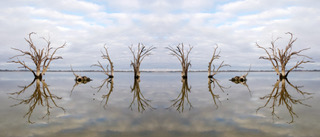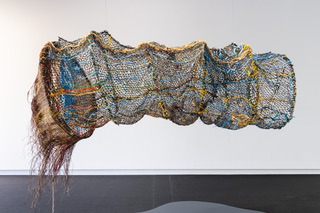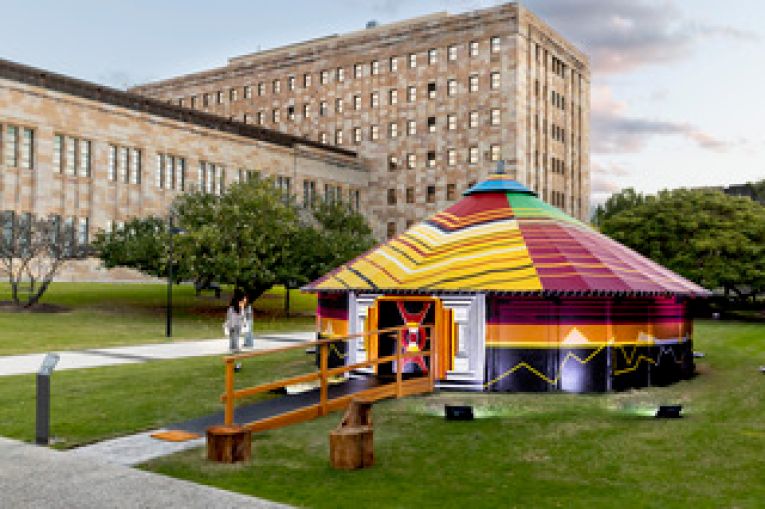Windows on the world: A quartet of shows to spark social and political change
A quartet of works open windows into the world of First Nations people and inspire a call for collective action for social and political change.

The four exhibitions on now at The University of Queensland Art Museum reflect its integration with the life of the university.
It’s not always the case for university galleries, but it’s been a focus since the UQ Art Museum was established in 1976, with increased attention to these connections over the past six years.
Yet this doesn’t mean that the exhibitions are esoteric – within a breadth of themes is material that is relatable and engaging.
Drawing together art by Aboriginal and Torres Strait Islander artists with film (NORTHERN WATERS by Rachel O’Reilly, and WE CALL YOU! SISTERS! MOTHERS! DAUGHTERS! by Sweden-based Petra Bauer), and Yuriyal Bridgeman’s SUNA (Middle Ground) installation (sited colourfully on the lawn outside the galleries), UQ Art Museum director Peta Rake describes the connections between these four exhibitions as “under the banner of collective action, with artist-led grassroots initiatives that create change and open up new space for new voices – which is core to our work here, driven by collaboration, and community”.
The largest of these four exhibitions is to come together as water, the first that Freja Carmichael has developed as UQ Art Museum curator, and the final in the Blue Assembly project, which Rake describes as “a long-term research arc exploring our relationship with water” in partnership with UQ’s Centre for Marine Science.

“Since 2022 we’ve been sharing and creating exhibitions, creative projects and research that challenges assumptions about the ocean, its role in human life, and its future, in the hope that we might inform policy around climate and the future of global communities,” Rake says.
You might like
“I can’t think of a better way for us to complete the series of exhibitions than with this beautiful and powerful exhibition that highlights First Nations perspectives on water protection.”

Evidence continues to emerge concerning the human connection to nature, not only for bodies but our minds. In each of these works/installations we are offered an insight into the way in which water and associated environments are viewed and reimagined by artists with Aboriginal and Torres Strait Islander lived experience, a demonstrably more holistic view.
In the paintings, video, sculpture and prints Carmichael has selected, water is canvassed less as a resource than an integral cultural practice – essential for kinship networks, the protection of plants and animals, and in tides and winds.
Artworks depict its fluidity, from the opening painting by Heather Koowootha (Wik-Mungkan/Kugu), which depicts Ngak Yangka (2021), a central waterhole with a series of smaller ones that exists in her grandmother’s Country, mapping the connections below the ground through aquifers. It contrasts a gold ground surface with the active water underground, noting sacred trees and rules that govern relationships between people and place.
From Jilamara Arts, YOYI is a performance captured as a four-channel video, with 30 artists presenting individual dances on Country to songs that speak to their totem. In each dance artists express their personal relationships and associated responsibilities to Country – a cultural system that ensures ecological balance. There’s a sense of community collaboration that enshrines water protection.
Quandamooka’s Megan Cope’s Whispers (poles) (2023) has oysters strung at eye level. It is a gallery version of a living artwork called Kinyingarra Guwinyanba (2022) that stands in the intertidal zone of Quandamooka waters.
Oysters are filter feeders, themselves cleansing the water. Whispers brings awareness to this role, profiling their potential resilience within a changing climate and its stressors amid a sense of the cultural and environmental systems that surround them.
Subscribe for updates
Solomon Booth’s (Aboriginal and Zenadth Kes/Torres Strait) formations of plastic may read visually as jellyfish – evocative reminders of the dangers to marine creatures in the Torres Strait; like turtles we might mistake the shapes for an animal.
Ghost nets (with pandanus) is the material used for Lharagula Ngididin (Crocodile Trap) (2022), a collaboration by Numbulwar Numburindi Arts from the dangerous floating nets that become marine debris in their coastal waters. This form, as large as a crocodile, innovates on a hunting tool to incorporate a contemporary narrative about care for saltwater.
Jimmy John Thaiday’s (Kuz and Peiudi clans) evocative video (with Kieran James) titled Just Beneath the Surface (2023) evokes other sea dangers, while Barkandji peoples’ Nici Cumpston’s portraits of Barka waterways (the Darling River) documents the decline of this powerful river in the face of human exploitation.
In these images she gives Country a voice. Brian Robinson (Kala Lagaw Ya and Wuthathi language groups) and Napuwarri Marawili (Madarrpa) also poetically narrate an indigenous and integrated environmental and cultural view of water – in a celestial narrative and memorial poles respectively.
The second exhibition is Rachel O’Reilly’s film, NORTHERN WATERS. With a more documentary flavour, it is a product of UQ Art Museum’s regional programming with community and elders on Djiru Country (in collaboration with James Cook University). Upstairs, Bauer’s films focus on feminised labour engaged in mundane tasks, using film as a part of a political practice.

Outside the museum, Bridgeman’s SUNA (pictured, above), first seen at the Biennale of Sydney in 2020, brings a replica of a Papua New Guinea Highlands round house to the university campus. It coincides with 50 years of PNG independence from Australian administration but also highlights the central importance of Bridgeman’s PNG heritage and collaboration within his practice.
In his village in the PNG highlands, the Hausman structure has become a meeting point for his Haus Yuriyal collective, a place to “overcome difference and create pathways of deeper understanding”.
One week in, Rake observes that SUNA’s “spirit of connection and community is already attracting large crowds, of students, staff and community members”.
It represents one of the ways in which the art museum is embedded into the life of the university – ”here it inspires thinking and shared understanding outside traditional teaching and learning contexts”.
SUNA (Middle Ground) continues until November 25; and To come together as water, NORTHERN WATERS and WE CALL YOU! SISTERS! MOTHERS! DAUGHTERS! continue until December 6 at UQ Art Museum, St Lucia, Brisbane.
Free to share
This article may be shared online or in print under a Creative Commons licence

